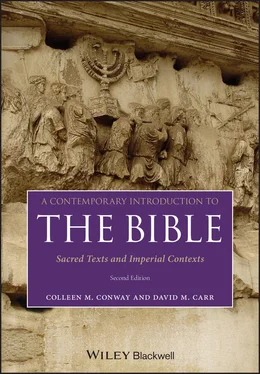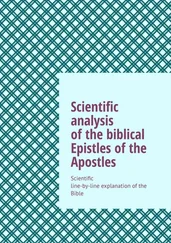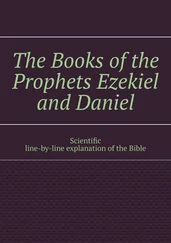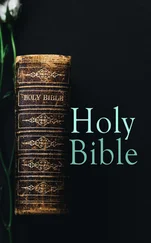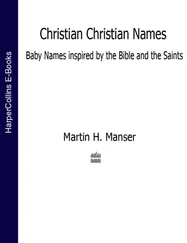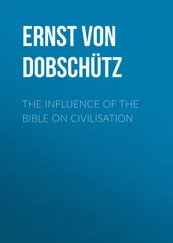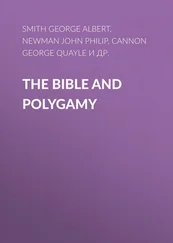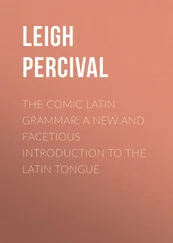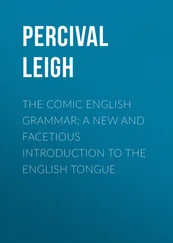African American Biblical Interpretation and the New Testament
Gender Criticism and Masculinity Studies
Cultural Criticism of the Bible
What Is in Special Topics Boxes?
These boxes offer extra information relevant to the broader discussion. Some pull together relevant dates for a period, while others show parallels between texts, or summarize information on a theme or question that relates to the topic at hand. This information is not optional or superfluous. Instead, these boxes highlight topics that are worth focused attention.
Contents of the Hebrew Bible/Tanakh/Old Testament
The Origins of Chapters and Verses11
AD, BC, BCE, and CE
Visualizing (the Possible Ancestors of) Ancient Israelites
The Name of Israel’s God: Yahweh/the LORD
The Name “Israel”
Archaeology and Problems of History Surrounding David, Solomon, and the Beginning of the Israelite Monarchy
Labels (e.g. “Psalm of David”): What They (Don’t) Tell Us
A View from the Assyrian Imperial Court: The Annals of Sennacherib
Hosea and the “Book of the Twelve Prophets”
Isaiah 6 and the “Call Narrative”
Overview: The Covenant Code and Deuteronomy
The Books of the Former and Latter Prophets
The Conquest and Ancient Holy War
Forced Labor for Exiles Under Nebuchadnezzar
The Divine Council
Traditions That Moses Wrote the Pentateuch
The Story of Jacob at Bethel as an Example of the Addition of Promise to an Older Story
More Information: The Gap Between Ancestors and Moses
J (the “Yahwistic source”), E (the “Elohistic source”), and the Documentary Hypothesis
Alternative Perspectives on Foreigners
The Emergence of “Judaism”
The Book of Judith (as an Example of a Hasmonean Text)
The Dead Sea Scrolls
The Infancy Gospel of Thomas: The Boy Jesus and His Superpowers
More on the Historical Jesus Search
Eschatology Versus Apocalypticism
The Structure of Paul’s Letters
Paul and Slavery
The Question of Circumcision
Changing Perspectives on Paul
Markan Priority
An Exorcism of Rome?
More on Messianic Secret
Jesus the “Son of Man”
Intercalation or the Markan “Sandwich”
A Glimpse of Life Under Roman Occupation
More About the Q Document
Gender and Matthew’s Genealogy (Matt 1:1–17)
Who Were the Pharisees?
Possessions and the Poor: A Lukan Puzzle
The Priene Calendar Inscription
Was There a Johannine Community?
Tacitus’s Account of Nero’s Persecution of Christians in Rome
This book introduces students to the books of the Bible as shaped in the crucible of the history of Israel and the early church. A prominent theme throughout is the way the books of the Bible reflect quite different sorts of interaction with empires that dominated the ancient Near East and Mediterranean. At first some students and professors may find this approach unusual, since we do not begin with Genesis and do not proceed through biblical books in order. The group of texts introduced early on in this textbook is quite different from the Bible they now know. So why have we chosen this approach? There are many advantages. On the basis of our experience with using this approach we have seen that the picture of the Bible’s development comes into focus as the narrative of its formation unfolds. By the end, students should find meaning in aspects of the Bible that they once overlooked, even as they also understand that much of the power of the Bible has been its capability to transcend the original contexts in which it was written. Moreover, through discussion of the history of Jewish and Christian interpretation of focus texts toward the end of many chapters, students will gain a taste of how faith communities have used the Bible in creative, inspired, and sometimes death-dealing ways to guide and make sense of their lives. Given the already large scope of this Introduction , we have focused on texts included in the Old and New Testaments, with a particular emphasis – in the case of the Hebrew Bible/Old Testament – on books included in the scriptures of Judaism and various forms of Christianity. This meant that we could not give sustained attention to apocryphal/deutero-canonical books of the Old Testament, or to the range of non-canonical early Christian works that did not end up being included in the Christian Bible.
The date framework given in this textbook follows that of Anson Rainey and Steven Notley’s The Sacred Bridge: Carta’s Atlas of the Biblical World (Jerusalem: Carta, 2005). In many cases specific dates are uncertain, but Rainey and Notley provide a recent, solid framework to start from on an introductory level. Unless otherwise indicated, the translations from Hebrew and Greek are our own.
As with any such textbook there is always room for improvement. We know that there are multiple ways in which virtually everything that is written here could be footnoted, qualified, and balanced with other perspectives. What this introduction provides is one general outline of a historical approach to the Bible that students can then supplement, correct, and balance in their future studies. We certainly invite all possible suggestions for correction and improvement of future editions of this textbook.
We have been helped by many people in writing this textbook. In particular, a diverse set of colleagues – Charles Carter, Thomas Dozeman, Esther Hamori, Mahri Leonard-Fleckman, Benjamin Sommer, Kent Reynolds, Robert Rezetko, Adele Reinhartz, Jerusha Rhodes, William Schniedewind, Mark Smith, and Marvin Sweeney – generously reviewed portions of chapters on the Hebrew Bible and/or offered advice on revisions and corrections for the first edition or this second edition. In addition, students at Union Theological Seminary and Seton Hall University have read chapter drafts and suggested corrections, and we received some further helpful suggestions from anonymous reviewers recruited by Wiley Blackwell. Some students and teaching assistants who have offered a particularly large volume of helpful corrections are Mary Ellen Kris, Candice Olson, Lizzie Berne-DeGear, Laurel Koepf-Taylor, Meagan Manas, and Todd Kennedy. Maia Kotrosits provided timely assistance with the glossary and web materials. Our thanks to all for their generous help in this project.
Finally, with love we dedicate this volume to our parents, James and Patricia Conway, John (now departed) and Adrienne Carr, whose love of teaching and care for their students helped inspire this book.
Colleen M. Conway and David M. Carr
The author and publisher gratefully acknowledge the permission granted to reproduce the copyrighted material in this book:
| Figure 0.1 |
Biblia Hebraica Stuttgartensia, edited by Karl Elliger and Wilhelm Rudolph, Fifth Revised Edition, edited by Adrian Schenker, © 1977 and 1997 Deutsche Bibelgesellschaft, Stuttgart. Used by permission. |
| Figure 0.2 |
Israel Talby/Israel images/Alamy Stock Photo |
| Figure 1.1 |
FALKENSTEINFOTO/Alamy Stock Photo |
| Figure 2.1 |
Zev Radovan/BibleLandPictures/Alamy Stock Photo |
| Figure 2.3 |
bpk/Vorderasiatisches Museum, SMB/Gudrun Stenzel |
| Figure 2.4 |
Jürgen Liepe |
| Figure 3.1 |
Lloyd K. Townsend |
| Figure 3.2 |
William Schniedewind |
| Figure 3.3 |
akg-images/Erich Lessing |
| Figure 3.4 |
Courtesy of R. E. Tappy and The Zeitah Excavations Photograph by B. Zuckerman and M. Lundberg, overlay by P. K. McCarter, Jr. |
| Figure 3.5 |
Zev Radovan/BibleLandPictures/Alamy Stock Photo |
| Figure 3.6 |
© The Trustees of the British Museum. All rights reserved |
| Figure 3.7 |
www.BibleLandPictures.com/AlamyStock Photo |
| Figure 3.8 |
Francis G. Mayer/Getty Images |
| Figure 4.1 |
Zev Radovan/BibleLandPictures/Alamy Stock Photo |
| Figure 4.2 |
akg-images/Erich Lessing |
| Figure 4.3 |
Zev Radovan/BibleLandPictures/Alamy Stock Photo |
| Figure 4.4 |
AP Images/NAM Y HUH |
| Figure 4.5 |
akg-images/Fototeca Gilardi |
| Figure 4.6 |
Stiftung BIBEL+ORIENT |
| Figure 4.7 |
Stiftung BIBEL+ORIENT |
| Figure 5.1 |
Stiftung BIBEL+ORIENT |
| Figure 6.1 |
Zev Radovan/BibleLandPictures/Alamy Stock Photo |
| Figure 6.2 |
akg-images/Erich Lessing |
| Figure 6.3 |
Puddingstone/Natural History Museum, London, UK/Bridgeman Images |
| Figure 7.1 |
Prisma by Dukas Presseagentur GmbH/Alamy Stock Photo |
| Figure 7.2 |
akg-images/Erich Lessing |
| Figure 8.1 |
Photo © The Israel Museum, Jerusalem |
| Figure 8.2 |
Courtesy of Carta, Jerusalem |
| Figure 9.1 |
Todd Bolen/ BiblePlaces.com |
| Figure 9.2 |
Bojan Brecelj/Getty Images |
| Figure 9.3 |
Berthold Werner, Image taken from https://commons.wikimedia.org/wiki/File:Jerusalem_Modell_BW_2.JPG |
| Figure 9.4 |
Hulton Archive/Getty Images |
| Figure 9.5 |
https://commons.wikimedia.org/wiki/File:Sbs-0008_028r_Jesus_macht_die_Tonv%C3%B6gelchen_lebendig.TIF |
| Figure 9.6 |
The Picture Art Collection/Alamy Stock Photo |
| Figure 10.1 |
Todd Bolen/ BiblePlaces.com |
| Figure 10.2 |
DEA/G. DAGLI ORTI/De Agostini/Getty Images |
| Figure 10.3 |
akg-images/Electa |
| Figure 10.4 |
DEA/G. DAGLI ORTI/De Agostini/Getty Images |
| Figure 10.5 |
Mary Evans Picture Library/Alinari |
| Figure 11.1 |
Courtesy of the American Numismatic Society |
| Figure 11.2 |
GRANGER COLLECTION (RDA)/Bridgeman Images |
| Figure 11.3 |
Courtesy of the Hecht Museum, University of Haifa, Israel |
| Figure 12.2 |
Richard Beacham (2005),The Emperor as Impresario: Producing the Pageantry of Power, pp 151-174. DOI: https://doi.org/10.1017/CCOL0521807964.008reproduced by Cambridge University Press |
| Figure 13.1 |
Deutsches Archäologisches Institut Rome, D-DAI-ROM 1975.1289/photo Rossa |
| Figure 13.2 |
Photo Scala, Florence |
| Figure 13.3 |
© The Trustees of the British Museum. All rights reserved |
| Figure 14.1 |
Reproduced by courtesy of the University Librarian and Director, The John Rylands University Library, The University of Manchester |
| Figure 14.2 |
Web Gallery of Art, Image taken from https://commons.wikimedia.org/wiki/File:13th-century_unknown_painters_-_Crucifixion_with_Two_Roundels_-_WGA23753.jpg |
| Figure 15.1 |
akg-images/Pirozzi |
| Figure 15.2 |
William Blake, Image taken from https://commons.wikimedia.org/wiki/File:Whore-of-babylon-blake-1809.jpg |
| Figure 16.1 |
Andre Nantel/Shutterstock.com |
| Figure 16.2 |
Granger, NYC./Granger Historical Picture Archive/Alamy Stock Photo |
Chapter opener photo © Joseph Chalev/Shutterstock.com
Читать дальше
